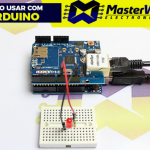
– Description:
The Ethernet Shield W5100 is a card that allows the Arduino to connect to a local network or the internet. It has the Wiznet W5100 chip and supports up to four socket connections simultaneously. The shield has a memory card slot (micro SD), where you can store files that can be sent over the local network / internet, and also has libraries for use by Arduino.
Due to the need to connect the Arduino to the world wide web, the Ethernet Shield W5100 was developed . Many projects developed with Arduino need access / control remotely and when using the Ethernet Shield W5100 this need is supplied in a simple and practical way, simply attach the shield to the Arduino, connect the shield to the router / modem through a RJ45 network cable, insert the correct source code into the Arduino and enjoy the benefits.
By inserting Arduino on the internet, you can access it from anywhere in the world, whether with a computer, smartphone or tablet and get information or request that actions be performed. For projects involving integration between Arduino and Android or iOS applications, the Ethernet Shield W5100 becomes an important member of the project. Because it is a shield, even attached to the top of the Arduino, you can still use most of the digital and analog ports on the board.
– Specifications and features:
– Supported protocols: TCP / IP, UDP, ICMP, IPv4 ARP, IGMP, PPPoE, Ethernet – Support (Full-duplex and half-duplex) – Controller: W5100
– Operating voltage: 3.3V – 5VDC
– Connection speed: 10 / 100Mb -Duplex) – Support ADSL connection (PPPoE with PAP / CHAP in authentication mode) – Support 4 independent connections simultaneously – Internal Memory: 16Kb for Tx / Rx buffers – Arduino connection via SPI
Practice wiring diagram:



COMMENTS